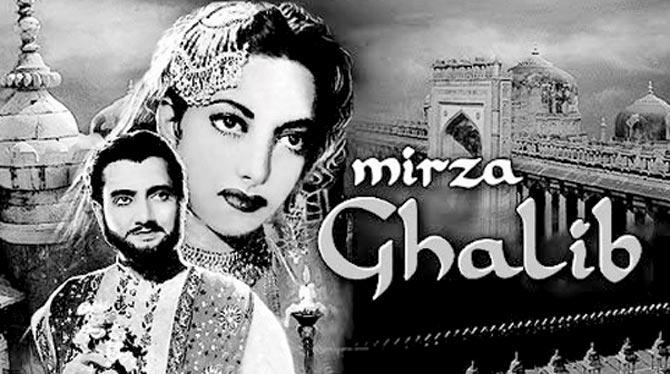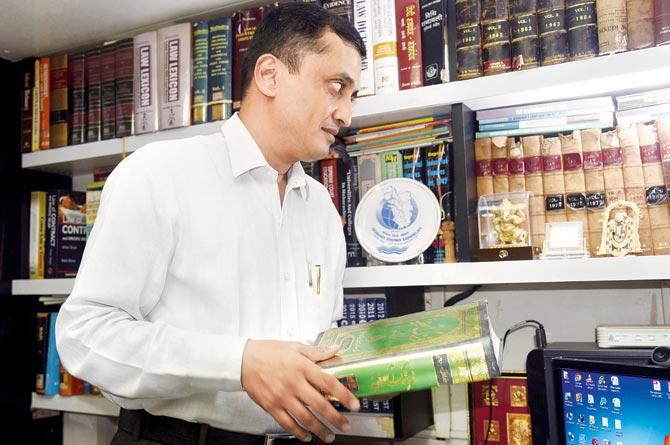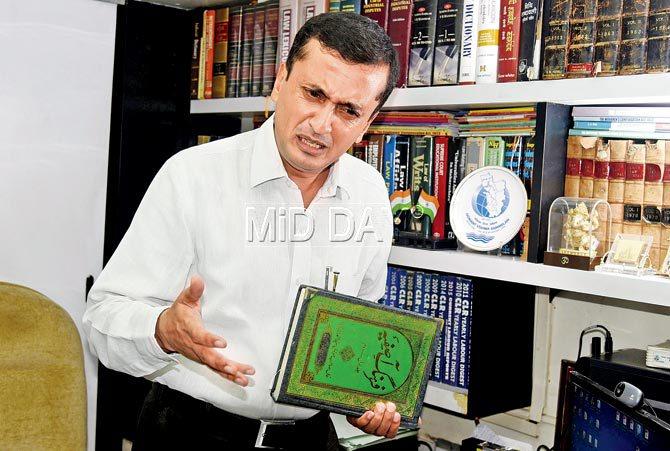Aside from arguing at Mumbai's Industrial Court, labour lawyer Satyanarayana Hegde deconstructs Urdu-Persian poetry of Mirza Ghalib in the shringaar kavya context. That's when he is not impersonating Kader Khan

A poster of Bharat Bhushan's Mirza Ghalib

A poster of Bharat Bhushan's Mirza Ghalib
 Did you have a Muslim girlfriend?" This question was put to Industrial Court lawyer Satyanarayana Hedge, 46, a few years ago when he was reading a volume of Urdu poetry by Faiz Ahmed Faiz during his Ghatkopar-Matunga commute.
Did you have a Muslim girlfriend?" This question was put to Industrial Court lawyer Satyanarayana Hedge, 46, a few years ago when he was reading a volume of Urdu poetry by Faiz Ahmed Faiz during his Ghatkopar-Matunga commute.
ADVERTISEMENT
Hegde uttered the usual line — "No, I take to Urdu, like people take to golf or swimming" — that he has offered, over the years, as the reason for diving into Urdu, Persian, Sanskrit, Hindi, Marathi and English ever since he was at school. Hegde has just penned his latest academic dissertation — a hitherto-untried interpretation of the Persian-Urdu master poet Mirza Asadullah Khan Ghalib in the Sanskrit-based poetic scheme.

Satyanarayana Hegde says he was attracted to Ghalib’s verse for its particular quality of 'meaning creation' which often reflects the qualities possessed by Sanskrit theorists who held that kavya was similar to shastra with a didactic, teaching function. Pic/Pradeep Dhivar
The Mumbai-based Kannadiga is once again armed with the same answer in response to probable inquiries into his literary pursuits. He is now used to the expectation of a correlation between his passion for Urdu and his legal profession; the surprise over a Hindu Brahmin's academic inclination towards Urdu masters.
Hegde feels the curiosity stems from language becoming a marker of religious and geographical identity. Ideally, it should be an amorphous, fluid and inclusive tool for bringing together distinct identities. "We subscribe to a very Colonial concept of language and identity. If we look at the past predating the British, we will be surprised that the Persian language in the Mughal era was the language of governance and literature across regions, which did not exclusively serve the Muslims, but Hindus," gushes Hegde, quickly enumerating the names of the voluminous Persian dictionaries which were compiled by Hindus.
The lexicon names — Mir'aat al-Istilaah (1745-46) of Anand Ram "Mukhlis", the Bahaar-e 'Ajam (1748-49) of Tek Chand "Bahaar" and the Mustalahaat al-Sho'araa (1767) of Lala Siyalkotimal "Waarastah" — come easily to Hegde who quotes them at various city fora while speaking on notions of cultural identity. He advocates his favourite theory on most occasions, that languages should not be limiting.

Satyanarayana Hegde
Hegde's earliest memories, rooted in Ghatkopar of the seventies, revolve around a peculiar brush with languages. Being the only child of a labor law consultant, he involuntarily absorbed legalese in his father's dictations to the stenographer. Against that backdrop were his mother's music tuitions which filled the drawing room air with Hindustani raagdari melody. While the family communicated in English and Kannada, Hegde's school offered a formal induction into Sanskrit. His mother was uneasy about the English and Hindi comic books that kept him engaged. She expressed her disapproval in corporeal ways, which didn't yield desired results. Hegde saved his pocket money to finance more audacious pursuits like watching one classic Hindi movie at Odeon talkies (today's R Odeon Mall) every day.
In the dark movie hall, away from the attention of his parents, Hegde savoured an odd mix — Pakeezah, Mughal-e-Azam, Dharam Veer, Yahudi ki Ladki, Mahal, Sholay — which, he says, contributed to a satvodrek on explosion of various rasas leading to supreme aesthetic delight. It was the beginning of a realisation of the power of Urdu-Hindi words. Even today, he instantly laces (Tumhara khoon khoon, hamara khoon pani) sparkling dialogues in casual conversation. He is also prone to impersonating film actors Raj Kumar, Kader Khan, Dharmendra, Ashok Kumar, Asrani, Jaideep, Amjad Khan, Ajit and a bit of Meena Kumari, who shaped the collegian in him. He has lost count of the times he has revisited the censored end of Sholay in which Thakur kills Gabbar. "As I started absorbing the lines, I realised words could heal and wound at the same time. I had to use them cautiously."
Hegde's attraction for the Urdu cadence had its genesis in his interest in the ghazal form. He says one ghazal plays in his mind through the day. But it all started with the first one he heard when he was a teen — Behzad Lakhnavi's Zinda hun is tarah ki gham-e zindagi nahin sung by Mukesh in Aag. Thereafter, he started reading as much Urdu literature as he could find in the Nagari script (Ayodhya Prasad Goyaliya's multi-volume series Sher-o Sukhan) and later the Perso-Arabic script. This, because he was unable to find a book to learn the Urdu script. Soon, the second-hand book stands lining the streets leading to the Churchgate station as well as the New and Second Hand Bookshop at Dhobi Talao became his second homes. His reading of Umberto Eco's The Name of the Rose pushed him into learning Latin and Greek.
Hegde was attracted to Ghalib's verse for its particular quality of 'meaning creation' — called mani-afrini in Persian-Urdu poetics — which, he feels, lies close to the qualities possessed by Sanskrit theorists (like Bhoja and Mahimabhatta) who held that kavya was similar to shastra with a didactic, teaching function. Hegde claims Ghalib's poetry rescued him repeatedly in times of love, anguish, despair and melancholy. "The pages of Ghalib's diwan (poetic anthology) seem to me the pages of my own life." To give an example of how Ghalib is applicable to his courtroom, he quotes: bak rahu00c4u0081 hu00c5u00abñ junu00c5u00abñ meñ kyu00c4u0081 kyu00c4u0081 kuch; kuchh nah samjhey ku00ccu00a3hudu00c4u0081 kare kou00c4u00ab (Lord I pray that no one comprehends; All that I rant and rave in ecstasy).
Hegde's recent rereading of Ghalib's verse through the interpretative paradigms of Sanskrit poetics (the Naayikaabheda context which is a taxonomical classification of Lovers, Beloveds and Messengers in the rasa-dhwani aesthetic) has an immediate reason. His essay on Ghalib is going to be part of the upcoming collection brought out by the prestigious Brill Publishers in honor of the prominent Urdu poet-novelist-lexicographer-culture critic Janab Shamsur Rahman Faruqui. He is most known for a ground-breaking four-volume study of the ghazal-poetry of the famed 18th century Urdu master poet Mir Taqi "Mir." Faruqi sahib (now an octogenarian based in Allahabad) had stated in his acceptance speech while receiving the Saraswati Samman (1996) that there were many aspects to Mir's poetry and poetics that were not to be found in the books of Arabic-Persian poetics, but they made more sense in the context of Sanskrit poets. In fact, Faruqisahib's formulation of fresh models of literary appreciation and creation of new reading protocols inspired Hegde to situate Ghalib in the Indic rasa-dhwani aesthetic.
When Hegde met Faruquisaab a few years ago at a Mumbai lecture, he asked him, playfully of course, "Why didn't you learn Sanskrit? It would have been a great gain for us." Hegde was referring to the decoding and cross referencing of texts that Faruquisaab imbibed in him. "It is the writing of people like Faruquisaab that taught me that you never finish reading a book. As you read one book, the other starts calling you and books start speaking to each other. One has to be open to hear them talking," says Hegde. He says many of Ghalib's couplets resist a typical sufi reading, whereas they can be better superimposed on the courtesans of Sanskrit literature. For instance, u00c4u0081shiq huwey haiñ u00c4u0081p bhu00c4u00ab ek awr shakhs par; u00c4u0081khir sitam ku00c4u00ab kuchh to muku00c4u0081fu00c4u0081t chu00c4u0081hiye, is ideally suited to the otherwise treacherous nu00c4u0081yiku00c4u0081 (courtesan) who has truly fallen for another man, and the nu00c4u0081yaku00c4u0081 is wishing that she too is betrayed and abandoned by her new lover, thereby affording recompense and retaliation (muku00c4u0081fu00c4u0081t) to the one she earlier troubled.
Hegde does not stop with Ghalib, but continues his decoding of other Urdu texts which resist conventional political notions of socio-cultural identity. As the usual business of city life goes on, the idea of learning and applying multiple perspectives to one truth remains dear to Hegde. He says the idea was fortified by a chance childhood meeting with famous singer Shobha Gurtu who told him learning was as nirantar as Goddess Saraswati's act of not keeping her veena down yet. In Urdu, nirtantar (constant) is mutawaatir!
Sumedha Raikar Mhatre is a culture columnist in search of the sub-text. You can reach her at sumedha.raikar@gmail.com
 Subscribe today by clicking the link and stay updated with the latest news!" Click here!
Subscribe today by clicking the link and stay updated with the latest news!" Click here!







